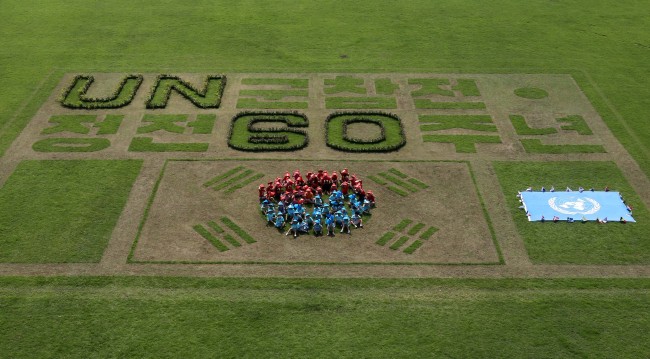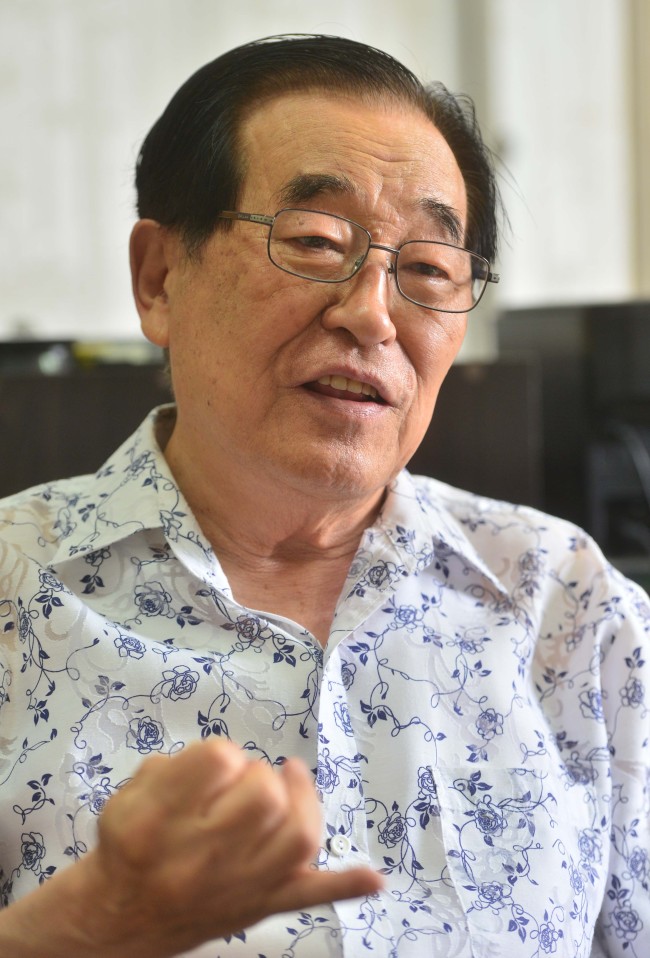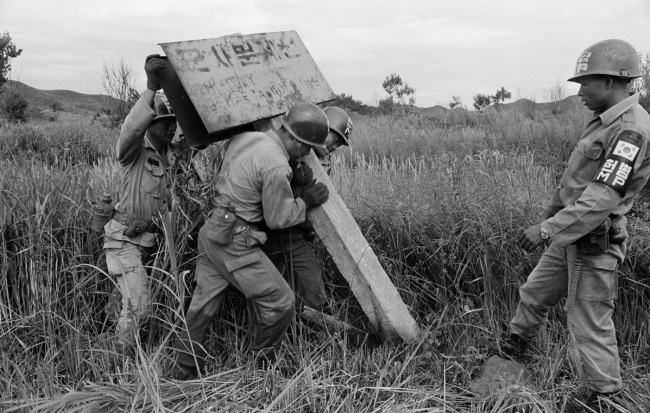60 years of division leaves humanitarian issues hanging
By Korea HeraldPublished : July 25, 2013 - 19:32

This is the seventh and last article in the series to mark the 60th anniversary of the armistice that halted the 1950-53 Korean War. ―Ed.
The armistice agreement six decades ago halted three years of hostilities on the peninsula. Yet, the enduring division has spawned a series of humanitarian issues between the two Koreas, including separated families and prisoners of war.
With the two neighbors remaining technically at war, the armistice leaves unresolved the daunting tasks of establishing permanent peace and reunification.
These issues have become more intractable in recent years as the inter-Korean relationship has plunged to one of its lowest ebbs with Pyongyang’s nuclear and missile development and Seoul’s resulting response.
When it comes to the urgent issue of divided relatives, experts said the two Koreas should push aside their political and ideological animosity and work together to heal the scars.
Separated families
Since 2010, the two Koreas have not held family reunions because of their strained ties under Pyongyang’s deadly provocations.
North Korea torpedoed the corvette Cheonan and shelled Yeonpyeongdo Island in 2010, killing a total of 50 South Koreans including two civilians. The provocations led to a halt in government-level dialogue and exchanges.
But, since 2000, the two Koreas have held 18 face-to-face reunions and seven video-link meetings, through which more than 4,320 families were reunited.
Shim Goo-seob, president of the association of separated families, stressed the urgency of the issue, referring to the old age of those who have loved ones in the impoverished state.
“More than half of those anxiously waiting for the day to meet their families are in their 80s. And each month, hundreds of them pass away,” Shim, 79, told The Korea Herald.
“In about five years, this issue will disappear as almost all of them will be gone by that time. That is why I am desperately seeking ways to enable the families to meet before they die.”
Since 1988, 128,824 people have registered with the government to find their loved ones in the North. More than 80 percent of them are aged 70 or older. Of the total, 55,960 have died. In May and June this year, as many as 613 registrants passed away.
A recent report by Hyundai Research Institute says the government has to set up reunions for more than 7,000 people each year to enable all of them to see their families before they die.
Shim, himself, has a younger brother and sister in the North. He and his father, who used to live in Jongpyong, South Hamgyeong Province, moved into the South in the late 1940s before the Korean War broke out.

As association chief, Shim has helped some 60 people meet their separated families in China or find the whereabouts of their families with the help of Chinese agents who can travel into North Korean territory.
“When I help old mothers and fathers meet their North Korean children in China, I always ensure that they have sedatives as most of them break down in tears and faint,” he said.
“One mother, I remember, cried and collapsed when she met in China her daughter who looked even older than her due to poverty and a difficult life in the isolated, poor country. One father gave his old son a piggyback, saying he was sorry he couldn’t do that when his son was little.”
His association has also helped people here send items such as medicine and clothes to their families in the North via mail through Chinese postal services. Shim expressed hopes that the two Koreas, at least, seek a way to enable regular mail exchanges among separated families.
“In the late 1940s before the war, the two Koreas allowed the separated families to exchange mail at the border village of Gaeseong, though it was possible after the authorities checked the mail contents,” he said.
“Our leaders could propose such a thing at high-level talks to help ease the pain the families have gone through for the past 60 years.”
Prisoners of war
Prisoners of war are another urgent humanitarian issue, which seems insurmountable as Pyongyang argues that all POWs were sent back to the South based on their choice, and that no one is living there against his will.
Based on statements from North Korean defectors and POWs who returned to their homeland, the Seoul government estimates that some 500 POWs are still alive in the North. Their average age is around 80.
A total of 80 have risked their lives to flee the repressive state and come back home and as of May, 29 of whom have passed away. One of the survivors is Yu Young-bok who returned to the South in 2000 after nearly five decades of hard work.
“We, POWs, all waited for the Seoul government to come to liberate us from the pain. We believed it would not leave us there like that for good. A decade, two decades ... four decades of yearning to return home were all in vain,” Yu, 84, told The Korea Herald.
Like Yu, POWs have been treated badly in the North, which has labeled them as “reactionary elements” of the communist state.
The Seoul government has stepped up efforts to address the POW issue. But it has dealt with it in a low-key manner as openly supporting their escape could endanger them and cause legal and diplomatic issues as they could first be classified as border trespassers into China.

Peace treaty remains elusive
Since the armistice agreement was signed, the peninsula has been in a curious state of neither peace nor war. Thus, formally ending the war with a peace treaty is a task facing the two Koreas tired of a relentless security dilemma.
But the prospect of a peace treaty still remains bleak with Pyongyang developing its missile and nuclear capabilities, and inter-Korean relations having worsened.
Experts said that first and foremost, a stable state of “genuine peace” should be forged before signing the paper peace treaty.
“Forging actual peace should precede the signing of the treaty. When threats of war continue with Pyongyang’s nuclear development, a peace treaty would not ensure peace,” retired Brigadier General Lee Sang-chul, a security expert, told The Korea Herald.
“Nuclear issues should first be addressed, inter-Korean military tensions should be eased and then sufficient military trust should be built for a peace treaty that would legally and institutionally uphold peace.”
The reclusive state has long called for a peace treaty with the U.S. while seeking to sideline the South in the process on the grounds that Seoul did not join the signing of the armistice.
On June 16, the North’s powerful National Defense Commission proposed talks to the U.S. over a set of issues including replacing the armistice with a peace treaty.
On June 21, Sin Son-ho, North Korea’s envoy to the U.N., renewed calls for a peace treaty with the U.S., underscoring that Pyongyang would not renounce its nuclear program until the U.S. ends what it calls “hostility” toward it. He also demanded that the U.N. Command, a central mechanism to uphold the armistice, be dismantled.
Conservatives here suspect the North’s demand is intended to pressure Washington to pull out its troops from the peninsula, retract its nuclear protection of the South and forge conditions conducive to communist reunification under its control.
They also argue that given Pyongyang’s unilateral breach of a series of inter-Korean agreements and threat to nullify the armistice, signing another treaty would not help improve peninsular security at all.
Above all, the most crucial condition before a peace treaty comes is Pyongyang’s denuclearization. But the elusive task has made little headway so far with the North sticking to its “nuclear deterrence” against hostile forces.
The North has so far conducted three underground nuclear tests including the latest in February and is also developing intercontinental delivery vehicles. It has already declared itself a nuclear state in its constitution and adopted a policy of concurrently pursuing economic development and nuclear armament.
During a security forum last November, then-presidential candidate Park Geun-hye hinted at her position that denuclearization should precede the signing of any peace treaty with the North.
“Genuine peace does not come when you simply sign a peace treaty,” she said.
“Right before World War II, British Prime Minister Neville Chamberlain held talks with Hitler of Germany at Munich and declared an era of peace. But their (peace) document became worthless less than a year later and a war broke out.”
Experts said the efforts toward a peace treaty should proceed under a two-plus-two formula involving the two Koreas, and the U.S. and China ― the parties that inked the armistice. They particularly stressed Seoul’s participation as the principle party to the treaty is the most crucial to ensure its enforcement.
By Song Sang-ho (sshluck@heraldcorp.com)
-
Articles by Korea Herald



















